2.1 A 50 kg mass at position i, =(7 m, 0m) is attracted to a 100 kg mass at position i0=(4m, 0m) and a 100 kg mass at position i,00=(10m, 0m) . Determine the gravitational force the 100 kg masses exert on GmM. the 50 kg mass. Reminder F= 2.2 A uniform plate has its boundary consisting of two concentric circles of inner and outer radii p and q, respectively, as shown in the sketch below. Determine the gravitational force which the plate exerts on a particle of mass M at its centre as shown in the sketch below.
2.1 A 50 kg mass at position i, =(7 m, 0m) is attracted to a 100 kg mass at position i0=(4m, 0m) and a 100 kg mass at position i,00=(10m, 0m) . Determine the gravitational force the 100 kg masses exert on GmM. the 50 kg mass. Reminder F= 2.2 A uniform plate has its boundary consisting of two concentric circles of inner and outer radii p and q, respectively, as shown in the sketch below. Determine the gravitational force which the plate exerts on a particle of mass M at its centre as shown in the sketch below.
Related questions
Question

Transcribed Image Text:2.1 A 50 kg mass at position i =(7m, Om) is attracted to a 100 kg mass at position i,0=(4m, 0m) and a
100 kg mass at position ip =(10m, 0m). Determine the gravitational force the 100 kg masses exert on
GmM,
the 50 kg mass. Reminder F=
2.2 A uniform plate has its boundary consisting of two concentric circles of inner and outer radii p and q,
respectively, as shown in the sketch below. Determine the gravitational force which the plate exerts on a
particle of mass M at its centre as shown in the sketch below.
Expert Solution
This question has been solved!
Explore an expertly crafted, step-by-step solution for a thorough understanding of key concepts.
Step by step
Solved in 2 steps with 1 images
